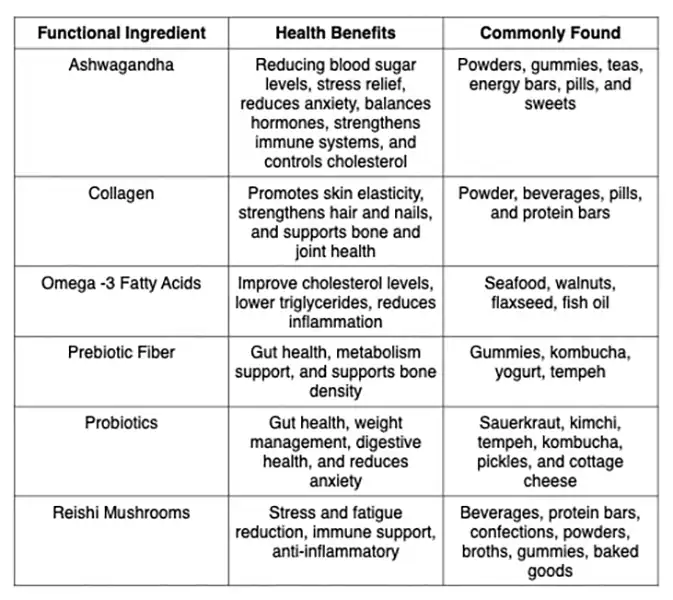Functional foods are one of the fastest-growing sectors in the food and beverage industry. These products go beyond basic nutrition, incorporating ingredients that deliver additional health benefits such as improved digestion, enhanced energy, stress relief, or skin support.
From probiotics in yogurts to ashwagandha in wellness shots and collagen in lattes, the concept is simple: pair everyday food and beverage formats with science-backed ingredients that improve wellness.
The numbers confirm this momentum. According to Fortune Business Insights, the global functional food market is projected to grow from $398 billion in 2022 to $793.6 billion by 2032. In the U.S., it’s expected to reach $117.2 billion over the same period.
But growth also comes with a challenge, health benefits don’t always taste delicious.
The Taste Challenge in Functional Formulation
While functional ingredients deliver real benefits, they often bring complex and unfamiliar flavor profiles. Ashwagandha can taste bitter and earthy, certain proteins contribute chalkiness or beany notes, and mushrooms add depth but may lean toward umami or mustiness. Even popular wellness inclusions like turmeric or ginger can overwhelm if not balanced carefully.
This is where the flavor industry becomes essential. The success of a functional food or beverage depends not only on what it does for the body but also on how it appeals to the consumer through taste, convenience, and overall experience. Consumers might try a functional product once for its health claims, but they will only buy it again if it tastes good.
Functional Beverages: A Case Study in Flavor Complexity
The beverage category shows just how important flavor solutions have become. Originally, functional drinks started with electrolyte hydration products like Gatorade. Today, the market has evolved into a diverse spectrum of functional drinks:
- Gut health formulations with probiotics and prebiotics.
- Cognitive and focus blends with nootropics and adaptogens.
- Mood and stress management products with calming herbal blends.
Each of these beverage types introduces taste complexities, from sour lactobacillus fermentation to bitter adaptogenic herbs.
At Jogue, we address these challenges by combining masking agents that soften or neutralize unpleasant notes, with appealing flavors that align with current trends. For example:
- Bitter adaptogens might be balanced with citrus, vanilla, or berry profiles.
- Earthy mushroom tones can be complemented with cocoa, coffee, or caramel.
- Protein chalkiness is often offset with indulgent dessert-inspired flavors like cookies & cream or chocolate peanut butter.
Expanding Flavor Solutions Across Functional Formats
While beverages lead the trend, functional ingredients are now embedded in a variety of categories:
- Bars and snacks enriched with protein, fiber, or botanical blends.
- Gummies delivering adaptogens, vitamins, or collagen in an appealing format
- Powders for smoothies, coffee, or milk alternatives.
- Plant-based dairy products like yogurts fortified with omega-3s, probiotics, or vitamins.
Each format has its own formulation and sensory challenges. Plant proteins can introduce bitterness or grassy notes. Omega-3 fortification can create subtle fishy or metallic tones. Heatprocessed snacks with botanical inclusions may suffer from flavor degradation over shelf life. The solution isn’t just masking, it’s flavor design. At Jogue, our R&D team specializes in flavor profile selection that works with the functional base rather than fight against it. This can mean designing flavors that embrace complexity (e.g., pairing turmeric with chai spices) or using indulgence to soften functional notes (e.g., vanilla latte collagen drinks).

Why Flavor Innovation Matters More Than Ever
The functional food market is maturing. In its early stage, consumers were willing to tolerate unusual flavors for the sake of health benefits. Today’s consumer, however, expects performance and enjoyment in the same product.
This expectation is shaping flavor development in three keyways:
- Upgraded Flavors: functional foods are taking flavor ideas from gourmet desserts, specialty coffee shops, and craft beverages to make them taste more indulgent.
- Global Influence: flavors from around the world like yuzu, matcha, black sesame, and saffron are being paired with functional ingredients in creative new ways.
- Clean-Label Focus: flavor solutions are being designed to fit clean-label and natural ingredient expectations, while still delivering great taste.
Flavor innovation is now a critical driver of repeat purchase, brand loyalty, and market growth in the functional category. At Jogue, our expertise in masking agents, custom flavor development, and trendaligned flavor creation ensures that functional foods and beverages are not only effective but also genuinely enjoyable.

